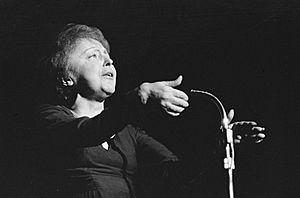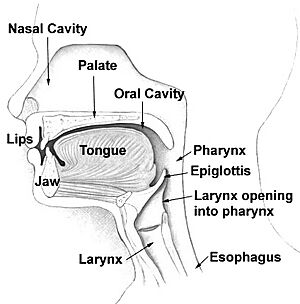Singing facts for kids
Singing is when a person uses their voice to make musical sounds. It's different from regular talking because singers use steady sounds, rhythm, and special voice tricks. A person who sings is called a singer or vocalist.
Singers perform many kinds of music, like songs or arias. They can sing with musical instruments helping them, or they can sing a cappella, which means without any instruments. Often, singers perform in a group called an ensemble, like a choir or a band. Some singers perform alone, while others sing with a huge symphony orchestra.
There are many different styles of singing around the world. These include opera, Indian music, gospel, traditional music, jazz, blues, pop, and rock.
Singing can be done for fun, as a hobby, or as a job. It can be formal, like a concert, or informal, like singing in the shower. To become good at singing, you need time, hard work, lessons, and lots of practice. Regular practice helps your voice become clearer and stronger. Professional singers often focus on one type of music, but some can sing well in many styles. They usually take voice lessons from special teachers.
Contents
How Do We Sing?

When you sing, you use the air in your lungs. You can control how much air comes out of your lungs with muscles, especially one called the diaphragm. This muscle is located below your rib cage. Singers spend a lot of time learning how to control their breath. This is called "breath control."
The air travels up through your throat to your larynx, also known as your voice box. Inside the larynx are your vocal folds (or vocal cords). These folds vibrate, like a reed on a clarinet, to control the air. This vibration helps make the sound higher or lower.
The sound then goes into your mouth, which acts like a space that makes the sound bigger. This is called "resonance." Professional singers learn to use their whole head as a resonator. They sometimes imagine a "mask" in front of their face to help make the sound louder and fuller. Finally, the sound comes out of your mouth so everyone can hear it. Singing is special because of the unique way your vocal cords are used compared to speaking.
Understanding Voice Types
Most people can sing notes that cover more than an octave (eight notes). Singers who practice a lot can often sing over two octaves. Singers are named based on whether their voices are higher or lower.
For women, the voice types are:
- Soprano: The highest female voice.
- Mezzo-soprano: A middle female voice.
- Contralto: The lowest female voice.
For men, the voice types are:
Some men can train their voices to sing high notes like an alto by using a special technique called falsetto. Children's voices are often called treble.
Different Ways to Sing
There are many different singing styles around the world, and each one uses a unique technique.
In Western classical music, singers often learn to sing in a style called bel canto. This means "beautiful singing" in Italian. It uses a lot of head resonance and creates a smooth, flowing sound. Bel canto was very popular in early Italian opera. Later, in the 19th century, composers like Richard Wagner wrote operas that needed singers to be more dramatic. Today, opera singers can have many different voice styles, including lyrical, dramatic, or coloratura (which means very high and light).
Singers in church choirs often use a lot of "head voice." This makes their sound beautiful and clear, especially in large buildings like cathedrals.
Pop singers usually have a different technique. Their singing often comes more from the throat. They don't need to develop super powerful voices like opera singers because they sing into microphones. These microphones make their voices louder using electronics.
Singing from different parts of the world can sound very unique. For example, Chinese singing can sound more nasal (as if sung through the nose). In Mongolia, there's a special technique called overtone singing. This makes one singer sound like they are producing two or more notes at the same time. In Switzerland, men often yodel, which involves quickly changing between chest voice and head voice.
Rap is a type of singing where the rhythm is the most important part. The voice goes up and down in pitch, but not always to specific musical notes. Scat singing in jazz is similar to rap, using improvised sounds instead of words.
Acappella singing is when people sing without any musical instruments. The name comes from Latin words meaning "without musical accompaniment." On the other hand, a Cantata is a type of music that is always sung with instruments.
Enjoying Singing
Singing is something everyone can enjoy! When a group of people sing together, it's often called a choir. People can sing in choirs, smaller groups, or by themselves (called a solo). You can sing just for fun, like in the shower, or you can practice hard and perform in concerts for an audience.
You can sing alone ("a cappella") or with "accompaniment" (usually with musical instruments). Some people say they are "tone-deaf," meaning they can't sing in tune. But almost everyone can learn to sing well if they try hard enough!
Related pages
Images for kids
See also
 In Spanish: Canto para niños
In Spanish: Canto para niños







